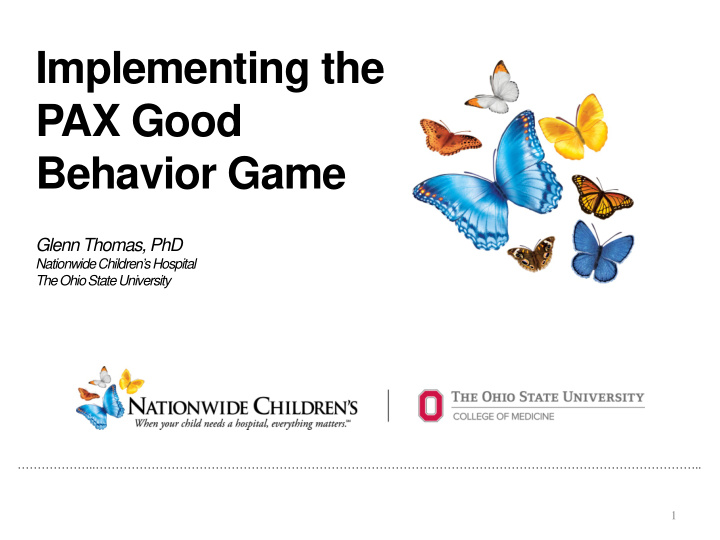



Implementing the PAX Good Behavior Game Glenn Thomas, PhD Nationwide Children’s Hospital The Ohio State University ………………..…………………………………………………………………………………………………………………………………….. 1
Disclosures • Dr. Thomas Glenn • Salary Support from Nationwide Children’s Hospital • No other potential conflicts of interest
Keep Us Well Asthma Prematurity Keep Us Well Behavioral Health HNHF 3
Healthy Neighborhoods, Healthy Families • Modeled after successful revitalization programs across the country, HNHF seeks to remove barriers to the health and well-being of thousands of families in our neighborhood (zip codes 43205, 43206, & 43207) using a multi-pronged approach. • As part of the NCH focus on wellness and population health, the 2013-2018 strategic plan expands the hospital’s commitment to the HNHF zone and calls for improvements in home, work and school environments as a pilot to demonstrate how best outcomes will come from best communities. 4
Caring for At-Risk Youth in Columbus, Ohio The NCH & CCS Partnership Target Schools in Year 1 Full Menu of Services Primary Care for Children & Adolescents Well Child Health Supervision Visits Sick care Immunizations Consultation with the School RN Linkage with other primary and specialty services Behavioral Health Services Individual and Family Treatment PAX Good Behavior Game (grades 1-5) Signs of Suicide (grades 6 -12) Other Services School-based Asthma Therapy Care coordination Partnership for dental services Source: Team Analysis 5
Columbus City Schools Demographic Data Enrollment: 53,327 Performance Index D % of Select Risk Factors Enrollment Economically Disadvantaged 79.0% Four Year Graduation Rate 77.00% Mobility (in the building less than 1 full 18.9% academic year) =10,000 students Source: Ohio Department of Education Interactive Local Report Card. Columbus City Schools 2013-2014 6 *Adequate Yearly Progress
PAX CCS Schools Demographic Data School Performance Index Economic Discipline Mobility Grade Disadvantage (Disciplinary actions ( Students in building less than 1 academic per 100 students) year) Broadleigh NA NA NA D Elementary Fairwood Alternative 93.4% 55 26.9% D Elementary Lincoln Park 95.0% 20.4 16.4% D Elementary Linden STEM NA NA NA D Academy Livingston 91.7% 158.8 25.3% F Elementary Moler Elementary 90.8% 61.7 25.3% D Ohio Avenue 92.3% 36.4 16.7% D Elementary Parsons Elementary 86.6% 23.1 15.9% C Siebert Elementary 91.8% 19.5 9.7% D Southwood 94.6% 67.3 25.5 D Elementary Watkins Elementary 86.0% 37.8 20.0% D Source: HNHF team 7
Canal Winchester Schools • School-based behavioral health services in 2 elementary schools in the Canal Winchester School District • Exurban • Also includes prevention services • Partially funded by Franklin County Alcohol Drug and Mental Health Board 8
Canal Winchester Schools Demographic Data Enrollment: 3, 457 Performance Index B % of Select Risk Factors Enrollment Economically Disadvantaged 29.40% Four Year Graduate Rate 94.5% Mobility (in the building less than 1 full 9.20% academic year) =1,000 students Source: Ohio Department of Education Interactive Local Report Card. Canal Winchester Schools 2013- 9 2014 *Adequate Yearly Progress
Implementation Timeline 60 50 40 CCS Classrooms CW Classrooms 30 CCS Schools CW Schools 20 10 0 2013-14 2014-15 2015-16 2016 10
2013-14 Columbus City Schools Classroom Spleem Data 50 45 40 Spleems/student/hour 35 30 Ohio - 1st grade 25 Moler - 1st grade 20 Moler- 2nd grade 15 10 5 0 Baseline Time 1 Time 2 Time 3 11
2014-15 Columbus City Schools Classroom Spleem Data 45 Spleems/student/hour 40 35 30 25 Average 20 15 10 5 0 Baseline Time 1 Time 2 Time 3 Time 4 12
2014-15 Canal Winchester Classroom Spleem Data 30 Spleems/student/hour 25 20 15 Average 10 5 0 Baseline October December March May 13
2015-16 Columbus City Schools School Spleem Data 50 Spleems/student/hour 45 40 35 Average 30 25 20.52 20.61 19.95 20 13.34 13.94 13.35 15 12.28 7.60 10 5 0
2015-16 Canal Winchester Schools School Spleem Data 12 Spleems/student/hour 10 8.75 8 Average 6 5.04 4.43 4.34 4 3.33 2.65 2.79 2.63 2 0
2016 (2 nd Semester) CCS Classroom Spleem Data 120.0 Spleems/student/hour 100.0 Average 80.0 63.6 60.3 60.0 40.4 36.2 40.0 20.0 0.0 Baseline March April May 16
Data Challenges • Functional definition of spleems • Baseline data • Consistent sampling of classrooms • Resource intensive • No comparison data • Ratings of teachers who were trained but did not do it • Rating teachers who did not get GBG training • Obtaining meaningful data from schools 17
Lessons Learned • Large urban school districts pose challenges • Increasing resources can also increase demands on school administrators • Buy-in from administrators important • Address locally as well as at senior leadership level • Buy-in from teachers critical • Clinician support makes a significant difference (not necessarily clinical services) 18
Lessons Learned, continued • PAX Partner training significantly increase clinicians’ proficiency • Need champions at all levels • Champions can develop locally: word of mouth • Incentives helpful ≠ culture change • Consider implementation for entire school • “Competing” interventions in community • Funding 19
Acknowledgements • David Axelson, MD • Lisa Alfriend • Jessie Cannon • Tara Clark • Columbus City Schools and Canal Winchester Teachers • Misti Dorsey • Kady Ermisch • Mary Kay Irwin • Brittany Johnson • Audrey Lombardo • Kara Penniman, LISW • Kam Twymon, LPCC-S • Douglas Wolf Contact Information: Glenn Thomas, PhD Glenn.Thomas@nationwidechildrens.org 20
Recommend
More recommend